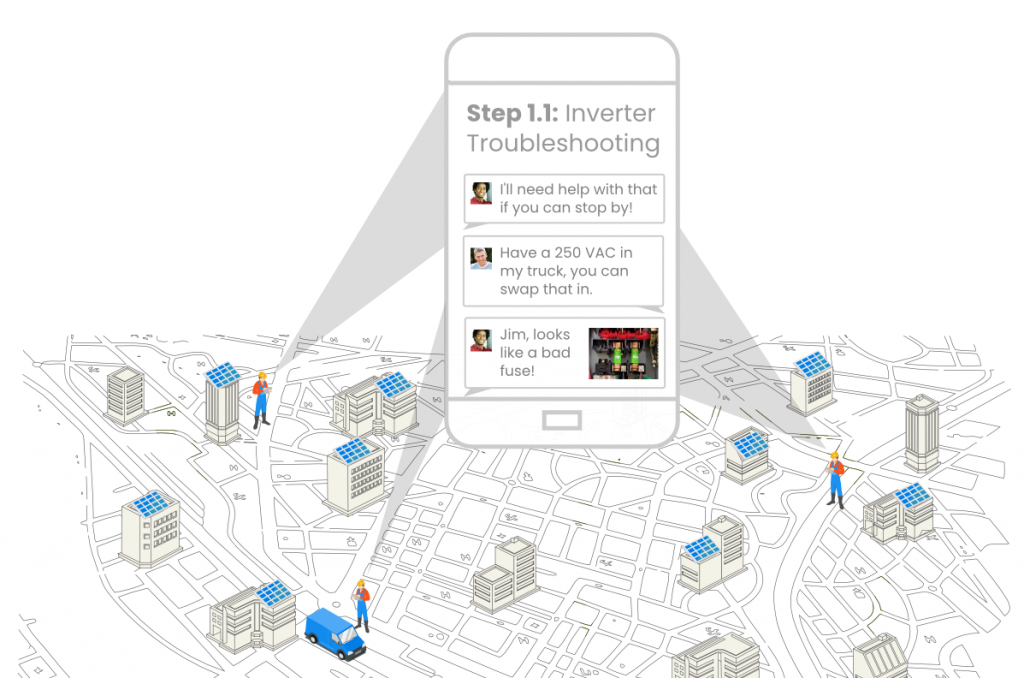You probably didn’t get into the solar business because you were excited about Information Technology (IT) but smooth-running solar IT is absolutely essential to optimizing your business and helping you stay one step ahead of the increasingly competitive solar market.
What do we mean when we talk about solar IT? This includes all the digital platforms and services your company relies on to operate. Communication between managers, installers, and your sales team, tracking the status of your orders and installations, customer relationship management and marketing, all depend on your company’s solar IT systems to run smoothly.
Of course, not every small solar company has the budget to hire dedicated IT personnel. Our advice? Start by prioritizing the IT systems that sit where the rubber meets the road on your operations.
Today, we’ll talk about why solar IT should be a priority for your business and how you can implement a winning IT strategy.
Why Should You Care About Solar IT?
We know how difficult it can be to run a small solar business and that worrying about IT is probably the last thing you want to do. But it’s important to recognize that solar IT is central to how your business runs and that you don’t need a degree in computer science to make sure you stay one step ahead.
1. Solar IT Systems Keep Your Business Running Smoothly
Think about your daily operations. On the sales side, your employees are sending emails to current and potential customers, logging leads, making calls, and transferring newly signed clients over to your installers. Your operations and installation teams are checking on what projects are scheduled when, what status they’re in, and how shipments of panels and other materials are progressing. Your management team is not only staying on top of all this activity, but also keeping track of accounting, making sure clients are billed and employees are paid on time, and working on recruiting new talent.
All of that hustle and interconnectivity depends on computer systems. For your business to function at maximum productivity, you need these systems to work both efficiently and in coordination with one another. A simple communication issue between your sales and installation teams could lead to frustrated customers. Or lost data between your sales and proposal teams could be enough to miss out on significant revenue.
2. Solar IT Makes Your Business More Competitive
IT systems need to evolve over time. In the current business environment, with the Solar ITC about to step down and eventually expire, it’s more important than ever that you reduce soft costs and bump up your business’s efficiency and therefore competitiveness.
How can a solar IT strategy help with that? One way is by making your employees more productive. Leading project management tools come with workflow automation features, so you could, for example, automatically send client data to your billing department when an installation is marked as complete. That not only saves your employees time, but also cuts down on the potential for miscommunication and tasks falling through. From the client’s perspective, it shows that your company is very much on top of its operations – a factor that could determine whether they recommend your business to friends and family.
Another way technology can help make your business more efficient is to coordinate installers in the field. For instance, Scoop helps with this by allowing installers to communicate seamlessly to facilitate projects, swap tools and parts as needed, and respond quickly when a customer has a service issue.

3. Solar IT Helps You Attract and Retain Talent
Another way solar IT affects your business is employee satisfaction. Your employees, after all, are the ones who have to interact with your project management, customer relationship management, and communication platforms every day. If they’re feeling frustrated because your business is dependent on slow, antiquated tools, that can manifest itself in an unhappy work environment and high employee turnover.
On the flip side, strong solar IT platforms can help solar employees feel like they’re getting work done and contributing to the success of your business. Plus, enabling seamless communication between departments and field operators does more than just add efficiency. It also leads to an engaging, collaborative workplace where employees can contribute to solving problems in real time.
The net effect is increased employee satisfaction, which can help you retain the talent that your small solar business relies on. Even better, modern and functional IT systems can help you recruit more talent as word spreads about how employees at your company work together as a mission-oriented team.
4. Solar IT Protects Your Business Against Risks
As your business grows so does your exposure to risk. This can come in a variety of shapes and forms including contractual risk, workplace health and safety incidents and associated liability, damage to client property and potential claims and many more. One primary way to reduce your exposure to risk is to ensure you have checks and balances in place and that you document all transactions and activities. Of course, this can be onerous and as a result many solar companies put off putting these controls in place. A comprehensive IT system can help with ensuring these checks are in place without overburdening the team. For example, an integrated document management capability can help keep track of solar customer proposals, drawings and contracts in a central place that is easy to access for all members of your team from sales to design to installation and ultimately services. You can ensure the contracts are properly reviewed and signed by all clients via a seamless integration with an e-signature tools such as Docusign.
On the field operations side, ensuring employees follow best practices for Job Hazard Analysis (JHA) and other safety precautions is key when it comes to reducing workplace safety risks. As one example, with Scoop’s ability to turn processes into easy to access work apps, ensuring both safety and quality steps are followed is no longer a headache. These steps can easily be built into apps that are easy to follow by employees in the field including the ability to verify steps with before and after pictures.
Crafting Your Solar IT Ecosystem
When it comes to putting together your business software system, you have two different options. You could go for an all-in-one solution that gives you access to a wide variety of business tools in a single software environment. Or you could choose a different software for each business function you need.
We’re in favor of the latter, and we’ll explain why.
Firstly, all-in-one solutions tend to come up short by their very nature. It might seem nice to have access to a wide variety of business tools in one place. But in reality, your installers probably need very different software than your design or proposal teams. Most all-in-one IT platforms tend to force both teams into a single suite of tools, leaving them each with an unhappy compromise.
Worse, all-in-one IT ecosystems are often inflexible and don’t allow your employees to work with outside software easily. So, if your platform lacks a function that your business needs down the line, you’re essentially out of luck. In essence, the main logic of all-in-one software is to create lock-in.
If you go the route of choosing multiple different business software solutions, you have a lot more flexibility. You can choose the sales platform that your sales team is most excited about, the solar design software that has the best features for your type of solar projects and the project management platform that offers field friendly features your installers and technicians will get the most out of.
Rather than compromising, it’s possible to get the best software in each category to maximize your business’s efficiency. This ‘best-of-breed’ approach is increasingly favored by IT professionals as the nature of work becomes more specialized and highly focused software tools can give your company a significant competitive advantage.
Of course, a key question that comes up is how to connect these various software tools together into a cohesive whole. This used to be a disadvantage of selecting best-of-breed tools as opposed to all-in-one. However, today most modern cloud-based software come with powerful APIs (Application Programming Interfaces) that allow them to talk to one another programmatically to pass on data or to relay workflows. The evolution of APIs means you no longer have to give up on collaboration across your business. Most individual business platforms are designed to integrate with a wide range of other software solutions. So, your sales and installation teams can run different task-specific platforms, but still work on the same communication networks and seamlessly transfer project data back and forth.
One step beyond APIs are Integration Platforms as a Service (iPaaS) such as Scoop’s GLOO™ platform that provide a highly flexible solution for not only connecting your best-of-breed solar IT tools but customizing the specific flow of data that is most optimal for your business. With iPaaS you can basically have your cake and eat it too. In other words, you can benefit from the best tools for each of your departments while ensuring a seamless flow of data and communication across these tools customized to your specific business logic.
Putting Solar IT to Work for Your Business
Building a winning IT strategy for your small solar business doesn’t have to be hard. Platforms like Scoop Solar offer advanced productivity, communication, and management tools that can help your business stand out. By integrating multiple best-of-breed business software solutions, you can help your business get an edge over the competition and maximize your efficiency. Get in touch with our team today for a free consultation on your IT strategy and requirements.


